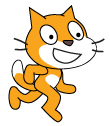Hinweis: Eine deutsche Fassung dieses Berichts findet sich auf meinem konzeptblog unter Meine SnapCon21 …
My observations and notes to the Snap! Conference 2021 while the impressions are still fresh..
 Yesterday the 3rd international meeting of the Snap! community came to an end, which now took place online for the 2nd time. With my mobility restrictions, this was very convenient for me at the moment. The small but very creative and active community met to exchange experiences and present new projects and developments. The mixture of keynotes, workshops (yes, that also works online), short contributions (5 minutes) and lectures (20 minutes) was again very instructive and profitable for me. Even social events (with lively participation) took place. The organisation was exemplary, there was a real conference atmosphere (Mags Amond summarised this very well in a Twitter-thread).
Yesterday the 3rd international meeting of the Snap! community came to an end, which now took place online for the 2nd time. With my mobility restrictions, this was very convenient for me at the moment. The small but very creative and active community met to exchange experiences and present new projects and developments. The mixture of keynotes, workshops (yes, that also works online), short contributions (5 minutes) and lectures (20 minutes) was again very instructive and profitable for me. Even social events (with lively participation) took place. The organisation was exemplary, there was a real conference atmosphere (Mags Amond summarised this very well in a Twitter-thread).
Two of the projects presented were dedicated to my main topic of art and coding. The PH Heidelberg offers the course Kunst durch Coding mit Snap! – Teil I & II (Art through Coding with Snap!). It is very low-threshold, with videos, exercises and tests. It is currently only available in German.  Glen Bull presented the course Creating Art, Animations, and Music through Coding (the book accompanying the course is available for dwnload). It’s interesting that the chapters are each based on the work of well-known artists and their recoding with Snap! I will have to take these suggestions into account for my current attempt at a teaching unit on coding art.
Glen Bull presented the course Creating Art, Animations, and Music through Coding (the book accompanying the course is available for dwnload). It’s interesting that the chapters are each based on the work of well-known artists and their recoding with Snap! I will have to take these suggestions into account for my current attempt at a teaching unit on coding art.
Snap! is aimed at a diverse audience: learners and teachers, pupils and students, developers and users. For the different requirements, it is quite helpful that there are now many libraries for Snap! that provide the necessary functionalities for specific  areas. Two new ones were introduced, SciSnap! by Eckart Modrow and Crayons & Color by Brian Harvey. However, the palettes of Snap!
areas. Two new ones were introduced, SciSnap! by Eckart Modrow and Crayons & Color by Brian Harvey. However, the palettes of Snap!
palettes can become quite confusing (the screenshot shows about 2/3  of this extension). I hope that the new functions from v. 7 onwards for personalisation (showing/hiding blocks/palettes) will offer enough flexibility to cope with this diversity. Netblox, on the other hand, gets by with very few powerful extensions, with which a whole range of very different distributed data processing applications can then be integrated into Snap!
of this extension). I hope that the new functions from v. 7 onwards for personalisation (showing/hiding blocks/palettes) will offer enough flexibility to cope with this diversity. Netblox, on the other hand, gets by with very few powerful extensions, with which a whole range of very different distributed data processing applications can then be integrated into Snap!
A special focus with many contributions was the direct integration of microcontrollers in Snap!. If you are interested in the variety, you should definitely have a look at the corresponding recordings! As soon as all this will be available as libraries in V. 7, I will hopefully be able to implement some ideas for interactive installations that have been lying around for a while.
Now I just have to find the time to process the many suggestions, test out the new functions and tools and then optimise my projects and start new ones.

